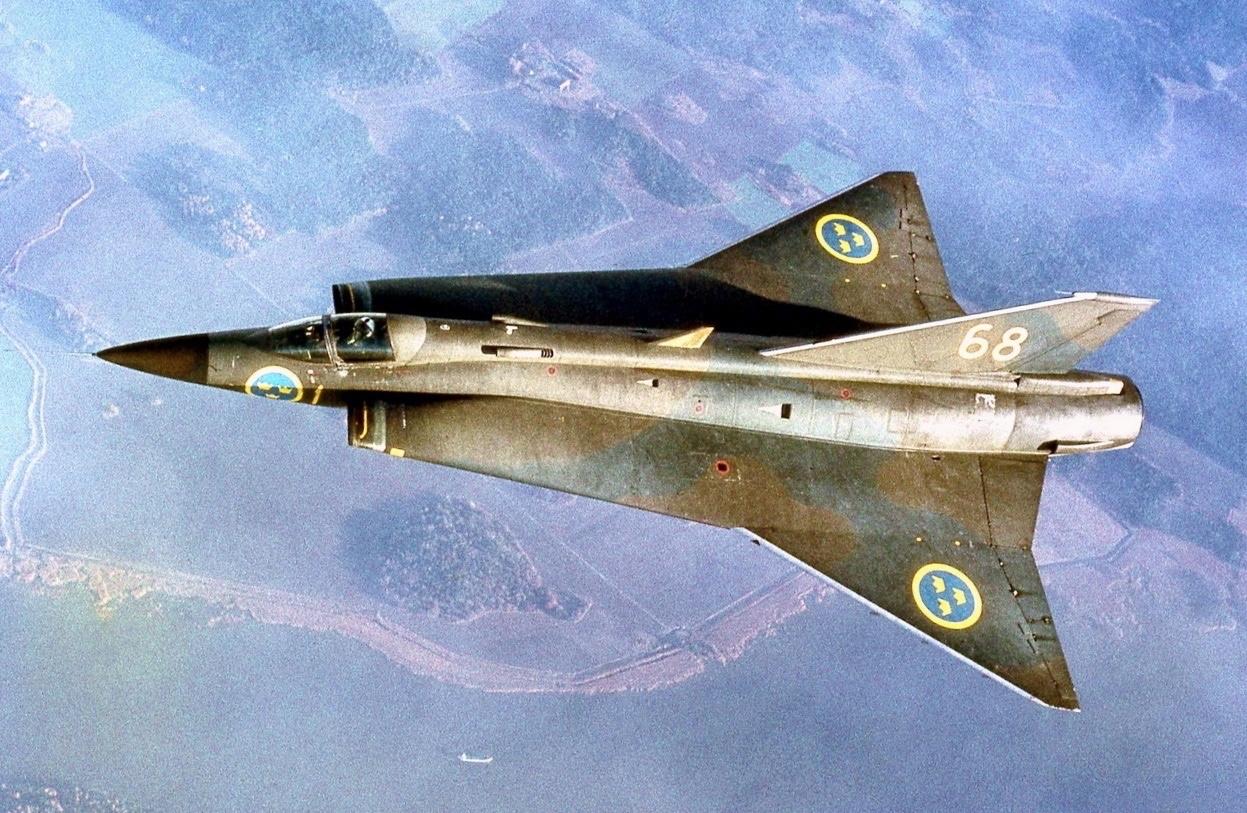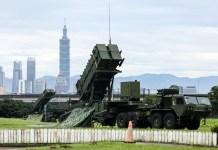About sixty-nine years ago, on October 25, 1955, the iconic Saab 35 Draken aircraft took its maiden flight, marking the beginning of the most daring and evolutionary chapter in the history of Swedish military aviation.
Although Sweden has now become the newest member of the US-led NATO Alliance, the Saab 35 Draken was conceived in an era when Sweden was known for its neutrality in the Cold War between the Western bloc and the Soviet Union.
Sitting closer to Russia, the center of the Soviet bloc, Sweden worried that a Cold War spillover would reach its territory and jeopardize its sovereignty.
In the late 1940s, Sweden saw the necessity for a warplane that could combat Soviet fighters and intercept Soviet bombers at high altitudes. This led to the development of the Saab 35 Draken Supersonic Fighter.
This new combat aircraft was required to conform with the Swedish Air Force’s (Flygvapnet) philosophy. Typically, this fighter would have to be able to operate from the reinforced public highways that were to be used as wartime airbases.
Moreover, Stockholm wanted the aircraft to operate from its unique air base system, Bas 60. The ingenious system emphasized the distribution of Swedish air power across several Swedish air bases in a bid to increase the chances of survival in the event of conflict.
Additionally, the aircraft had to be designed to be rearmed and refueled by untrained conscripts in ten minutes or less.
The Swedish engineers developed a novel “double delta” design element that symbolized an entirely new age of aeronautical design. The wing design consisted of two paired delta wings, with one delta wing enclosed within another larger delta wing.
For optimal performance at low speeds, the outer wing had a 60-degree angle, while the inner wing had an 80-degree angle for high-speed performance. Needless to say, the Draken-35 was distinguished as the most aesthetically pleasing combat aircraft.
A stingray-like silhouette emerged from beneath the Draken. The sleek, integrated fuselage looked like two halves fastened together with bolts.
The aircraft’s maximum speed was 2,450 kilometers per hour, and its service ceiling was 66,000 feet. By the 1950s, its design resembled a kite, and it kept that nickname, though the translation of Draken is “dragon.”
While the design was exotic, it was untested.
In 1952, they built a small test aircraft, the Saab 210, a scaled-down but flyable double delta wing design nicknamed ‘Lilldraken,’ meaning the little dragon. It was propelled by the Armstrong Siddeley Adder jet engine and demonstrated the feasibility of the wing design when Bengt Olow piloted it on its first flight on January 21, 1952.
China “Deploys” Counter-Stealth Radar, Anti-Ship Missile Battery To Fortify Triton Island – Reports
The odd aircraft had a top speed of about 400 mph and was put through rigorous testing. The first Draken-35 prototype was propelled by a license-built Rolls Royce Avon Mk 21 engine and made its first flight on October 25, 1955. The second prototype, equipped with an afterburner, unintentionally broke the sound barrier on a climb during its first flight.

SAAB 35 Draken Gave Sweden Many Firsts
Saab 35 Draken was a ground-breaking aircraft that broke several records. It became the first airframe constructed in Western Europe that could fly at real supersonic speeds. The Draken achieved Mach 2.0 and was tuned for high-speed operations. It finally entered production in 1957.
It was a single-engine aircraft capable of carrying various weapons, including the AIM-9 Sidewinder missile. The Swedish jet could also carry a nearly 6,400-pound payload, which included bombs and rockets stored internally.
The 35 Draken proved to be a very capable fighter jet despite being built as a high-altitude interceptor rather than a dogfighter. Its high speed and incredible quick-turn capability allowed it to operate at all altitudes. Saab also manufactured a limited number of twin-seat J 35C training aircraft to aid pilots in switching to the type.
The wings of the Saab 35 Draken enabled the aircraft to gain more speed and maneuverability and allowed it to carry additional weaponry and fuel.
However, it occasionally experienced “superstar” or abrupt altitude loss brought on by instability caused by the tail-less design. It would become uncontrollable regardless of pilot action, leaving ejection as the plausible choice. Unfortunately, this caused several tragic accidents.
Pilots had to develop strategies to survive these crises. The pilots eventually overcame the superstars by performing a “Cobra Maneuver,” which entailed quickly raising the nose to the point where the aircraft would turn 90 degrees vertical to the ground.
This is what happened on the Cobra Maneuver: The airframe created a massive airbrake when the pilot was facing the sky, causing the airplane to slow down rapidly. The movement resembled a cobra spreading its hood. With this, the Draken-35 became the first aircraft to perform the Cobra maneuver.
The Swedish Air Force (SAF) flew eight Draken variants in a row. Notable improvements in avionics, aerodynamics, fuel capacity, or more weapons storage were incorporated in each variant. Additionally, four export variants were constructed for Sweden, Denmark, Finland, and Austria. Intriguingly, of more than 600 Drakens constructed over the years, 51 were shipped to Denmark alone.
All Drakens were interceptors with restricted air-to-ground capability except Danish Drakens, which operated as strike aircraft and were equipped with a combination of AGM-12 Bullpup air-to-ground missiles, electronic countermeasures, and improved internal and external fuel storage.

Despite the technological issues it encountered since its inception, the Draken enjoyed a great reputation. Austria continued to use them until 2005, so they were in service for fifty years. Up until 2009, the United States also employed 12 original Danish Saab 35s for training purposes.
It is safe to say that the Swedish Air Force’s primary fighter-interceptor, the Saab 35 Draken, would have performed admirably against any Soviet aircraft. Aviation buffs and military enthusiasts consider it a travesty that this aeronautical marvel never saw combat.
By the mid-1980s, the more sophisticated JA 37 Viggen fighter had mostly replaced the SAF’s Drakens, while the more potent Saab JAS 39 Gripen fighter was anticipated to enter service within ten years, albeit behind schedule.
This was the period of relative calm as the Cold War had ended. Due to budget cuts and high maintenance expenses, the SAF decided to retire the Draken in December 1999.
While many former operational aircraft have been preserved in the countries that operated the aircraft, quite a few Drakens are currently owned by civilians, primarily in the US.
- Contact the author at sakshi.tiwari9555 (at) gmail.com
- Follow EurAsian Times on Google News




